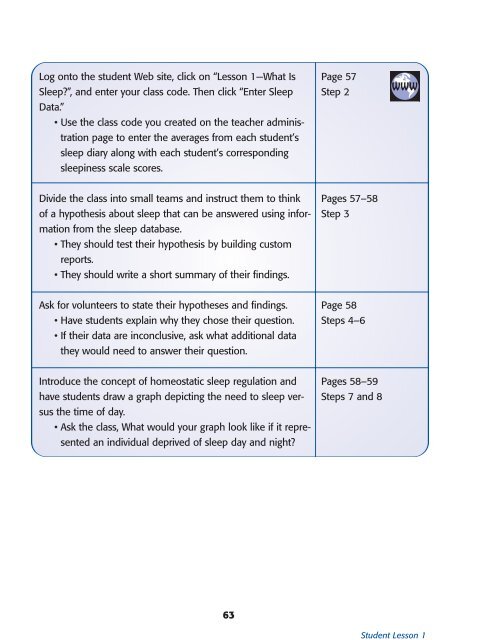Biological - NIH Office of Science Education - National Institutes of ...
Biological - NIH Office of Science Education - National Institutes of ...
Biological - NIH Office of Science Education - National Institutes of ...
Create successful ePaper yourself
Turn your PDF publications into a flip-book with our unique Google optimized e-Paper software.
Log onto the student Web site, click on “Lesson 1—What Is<br />
Sleep?”, and enter your class code. Then click “Enter Sleep<br />
Data.”<br />
• Use the class code you created on the teacher administration<br />
page to enter the averages from each student’s<br />
sleep diary along with each student’s corresponding<br />
sleepiness scale scores.<br />
Page 57<br />
Step 2<br />
Divide the class into small teams and instruct them to think<br />
<strong>of</strong> a hypothesis about sleep that can be answered using information<br />
from the sleep database.<br />
• They should test their hypothesis by building custom<br />
reports.<br />
• They should write a short summary <strong>of</strong> their findings.<br />
Pages 57–58<br />
Step 3<br />
Ask for volunteers to state their hypotheses and findings.<br />
• Have students explain why they chose their question.<br />
• If their data are inconclusive, ask what additional data<br />
they would need to answer their question.<br />
Page 58<br />
Steps 4–6<br />
Introduce the concept <strong>of</strong> homeostatic sleep regulation and<br />
have students draw a graph depicting the need to sleep versus<br />
the time <strong>of</strong> day.<br />
• Ask the class, What would your graph look like if it represented<br />
an individual deprived <strong>of</strong> sleep day and night?<br />
Pages 58–59<br />
Steps 7 and 8<br />
63<br />
Student Lesson 1

















